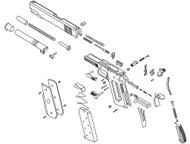Completing Your 1911
Posted by Tactical Machining Engineering Team on Jun 23rd 2021
Building a 1911 is the gold standard of home gunsmithing. It’s a challenging, rewarding process that results in a classic piece of American engineering. Unlike the AR platform, which primarily involves routing the fire control pocket, the 80% 1911 frame requires several highly specialized machining steps to ensure flawless function.
If you've tackled an 80% AR-15 build, understand that the 1911 requires a higher degree of precision and specific tools. Here is a breakdown of the three most critical machining operations required to complete your frame.
1. Machining the Slide Rails
The **slide rails** are arguably the most critical component on the 1911 frame. They must be cut precisely and parallel to ensure the slide moves smoothly and locks up correctly. An improper cut will result in binding, excessive wear, or total functional failure.
Due to the complexity of this step, specialized rail-cutting jigs are mandatory. These jigs use guide blocks and a cutter that shave the aluminum down to the exact specification needed for your slide. This step cannot be performed reliably without the correct dedicated tooling.
2. Drilling the Pin Holes
The 1911 frame requires several holes to be drilled, the most important of which are for the **Hammer and Sear Pins**. These pin holes must be perpendicular to the frame rails and perfectly aligned to ensure the fire control group operates cleanly and reliably.
Required Tools: While a standard drill press can be used, a high-quality jig is essential to guide the drill bits and maintain precise alignment. Any deviation here will result in a heavy, gritty trigger or a failure to reset.
3. Decking the Frame and Barrel Seat
The term "decking" refers to machining the top surface of the frame to its final height, which is often necessary if you start with a slightly oversized casting or forging.
More complex still is the **Barrel Seat**. Machining the barrel seat is necessary to achieve the proper lockup between the barrel and the slide. A dedicated barrel seat cutting tool is required here to ensure a reliable and accurate build.
The Final Word on Precision
The 1911 tolerates very little deviation. While the challenge is higher than an AR build, the final result—a custom-built pistol with tight tolerances—is unparalleled. Always review your jig manufacturer's instructions thoroughly and take your time. There are no shortcuts in building a legacy.
Frequently Asked Questions (FAQ)
Q: What specialized tools are required for an 80% 1911 build?
A: You absolutely need a dedicated 1911 jig, a slide rail cutter, and specialized drill bits. Standard power tools are often insufficient for the required precision.
Q: Is building an 80% 1911 harder than an AR-15?
A: Yes. The 1911 build is more complex due to the extremely tight tolerances and specialized machining required for the slide rails and the internal fire control components.
Q: What is the most common mistake when cutting 1911 rails?
A: Improper alignment or removing too much material. This results in the slide binding or excessive play, which usually requires professional repair or scrapping the frame.

